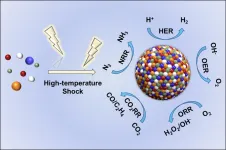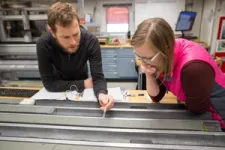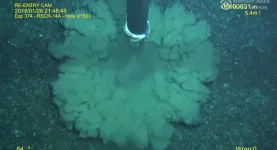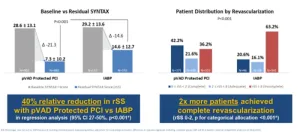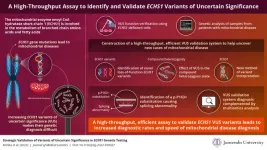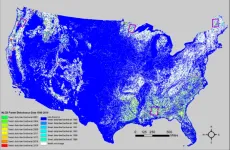(Press-News.org)
High-temperature shock (HTS) is an emerging synthesis method with kinetics-dominated non-equilibrium characteristics, which can achieve an ultrafast heating/cooling rate of ~10^5 K/s and a peak temperature larger than ~3000 K within a time scale of seconds or milliseconds, and is widely used in the preparation of high entropy content, thermodynamic metastable phase and defect-rich materials. Amongst these significant advances, nanoscale high entropy alloys (HEA) are particularly prominent in heterogeneous catalytic reactions with remarkable activity, selectivity, and stability due to flexible composition space and high-entropy mixing structure. There are numerous reports on using the HTS technologies to fabricate HEA and other high entropy materials in recent years, however, the construction strategies and inherent physicochemical fundamentals of HTS still remain to be thoroughly summarized and explored.
Recently, a research team led by Prof. Yanan Chen from Tianjin University and Dr. Ye-Chuang Han from Xiamen University, China, presented physicochemical principles of HTS from the “energy-space-time” perspective, introduced representative HTS technologies (e.g., Joule heating, laser heating, microwave heating), summarized the advantages of HTS compared to traditionally thermodynamic-dominated near-equilibrium heating methods (e.g., tube furnace and muffle furnace) on synthesizing catalysts. In addition, the concepts and features of HEA were introduced, and the latest progress in the synthesis of HEAs using the HTS techniques was reviewed. Finally, conclusions and perspectives were also provided for future investigations of HTS and HEA, which has great significance to guide both the theoretical and experimental development of HTS and its application in HEA controllable preparations. The results were published in Chinese Journal of Catalysis (DOI: 10.1016/S1872-2067(23)64428-6).
From the “energy-space-time” perspective, combining the law of conservation of energy and the relationship between heat and temperature, the factors of the heating rate for HTS can be deduced as follows: the absorption coefficient (ξ), the power of input energy (P), and the natural features (specific heat capacity (c), mass (m)) of materials. Especially, the absorption coefficient is interrelated with the features of reactants and substrates, reaction environment, and heating approaches. In addition, the input energy directly effects on the target during HTS, therefore, the reaction volume (V) is a crucial parameter, and the heating rate depends on power density(E/t/V), which is the coupling of energy (E), space (V) and time (t). The higher the power density (means the greater energy, smaller space, shorter time), the faster the heating rate. The cooling process is mainly determined by the natural features of the materials due to the lack of energy input.
HEA exhibits excellent catalytic activity and stability due to their four unique effects: thermodynamic high entropy, structural lattice distortion, kinetic sluggish diffusion, and “cocktail” effects. However, traditional methods used to prepare HEA have mostly resulted in large-sized bulk materials with small specific surface areas, thereby greatly hindering catalytic applications. HTS can inhibit the coalescence and growth of HEA nanoparticles. The authors summarized the latest progress in the preparation of HEA and other high entropy materials using typical HTS technologies (Joule heating, laser heating, and microwave heating), as well as their applications in catalytic reactions. Finally, outlooks were provided from the extreme non-equilibrium conditions and equipment of HTS, the rational design, advanced characterization and high-throughput screening of HEA, which are greatly significant in promoting their prosperities.
###
This work was supported by the Natural Science Foundation of China (Grant Nos. 52171219 and 91963113), and the China Postdoctoral Science Foundation (2022M722646).
About the Journal
Chinese Journal of Catalysis is co-sponsored by Dalian Institute of Chemical Physics, Chinese Academy of Sciences and Chinese Chemical Society, and it is currently published by Elsevier group. This monthly journal publishes in English timely contributions of original and rigorously reviewed manuscripts covering all areas of catalysis. The journal publishes Reviews, Accounts, Communications, Articles, Highlights, Perspectives, and Viewpoints of highly scientific values that help understanding and defining of new concepts in both fundamental issues and practical applications of catalysis. Chinese Journal of Catalysis ranks among the top two journals in Applied Chemistry with a current SCI impact factor of 12.92. The Editors-in-Chief are Profs. Can Li and Tao Zhang.
At Elsevier http://www.journals.elsevier.com/chinese-journal-of-catalysis
Manuscript submission https://mc03.manuscriptcentral.com/cjcatal
END
DANVERS, Mass., May 18, 2023 – Abiomed, part of Johnson & Johnson MedTech[1], announces results of a third-party analysis showing that utilizing Impella during high-risk percutaneous coronary intervention (PCI) procedures may help physicians achieve a more complete revascularization compared to high-risk PCIs supported using an intra-aortic balloon pump (IABP). Previous studies have shown that a more complete revascularization can lead to longer survival[2],[3], a greater reduction in heart failure and angina symptoms[4], and an improved quality of life for the patient[5].
This analysis shows ...
The gene ECHS1 encodes for enoyl-CoA hydratase short-chain 1, a mitochondrial enzyme involved in branched-chain amino acid and fatty acid metabolism. Rare inherited mutations in the ECHS1 lead to mitochondrial ECHS1 deficiency, resulting in the disruption of the metabolism of the essential amino acid valine and accumulation of valine intermediates.
In fact, ECHS1 is one of the most common causative genes of mitochondrial diseases. These mutant enzymes also cause brain lesions and severe delays in a child’s psychomotor development, along with elevating blood lactate levels. ECHS1 variants have been reported globally, and many disease-causing ...
Every second, the planet loses a stretch of forest equivalent to a football field due to
logging, fires, insect infestation, disease, wind, drought, and other factors. In a recently published study, researchers from the U.S. Geological Survey Earth Resources Observation and Science (EROS) Center presented a comprehensive strategy to detect when and where forest disturbance happens at a large scale and provide a deeper understanding of forest change.
The study was published on Feb. 28 in the Journal of Remote Sensing.
“Our strategy leads to more accurate land cover ...
Most global scenarios and governmental targets for decarbonizing the transport sector consider battery-powered electric vehicles as a main part of the solution. Enormous amounts of raw materials are needed to build enough batteries and ensure a transition to low-emission vehicles.
Access to lithium is critical, as it is used in all types of EV batteries.
Future demand needs to decrease
“It seems very likely we'll have a shortage. The key lies in the demand. The demand needs to decrease to avoid long-term supply problems,” ...
Satellites launched into outer space could send back improved warnings of dangerous solar storms thanks to a breakthrough in the way scientists use space weather measurements.
Experts from the University of Reading have found that using satellite data that is less reliable but is returned to Earth rapidly can be used to improve the accuracy of solar wind forecasts - which are harmful streams of charged particles sent from the sun - by nearly 50 per cent.
Their research, published today (Thursday, 18 May) in Space Weather, ...
A new study uncovers how the interplay between Sargassum spp., plastic marine debris and Vibrio bacteria creates the perfect “pathogen” storm that has implications for both marine life and public health. Vibrio bacteria are found in waters around the world and are the dominant cause of death in humans from the marine environment. For example, Vibrio vulnificus, sometimes referred to as flesh-eating bacteria, can cause life-threatening foodborne illnesses from seafood consumption as well as disease and death from open wound infections.
Since 2011, ...
A new study by Dr. Lucie Kvasničková Stanislavská from Czech University of Life Sciences, Prague published in PeerJ Computer Science titled ‘Global analysis of Twitter communication in corporate social responsibility area: sustainability, climate change, and waste management’ has found that social media is an increasingly important tool for companies to communicate their corporate social responsibility (CSR) efforts. The study analyzed over half a million tweets from 2017 to 2022 and identified the key topics and trends communicated in connection with CSR on Twitter.
“Our results aid enterprises in developing communication ...
PHOENIX (May 18, 2023) – The Society for Cardiovascular Angiography & Interventions (SCAI) today release an expert consensus on the management of in-stent restenosis and stent thrombosis. The statement was published online in the Journal of the Society for Cardiovascular Angiography &
Interventions (JSCAI).
In-stent restenosis is a blockage or narrowing that comes back in the portion of the coronary artery previously treated with a stent and remains a common clinical problem despite numerous improvements in stent design and polymer coatings in recent years. In addition to significant health care
costs, it is also associated with an increased risk of death and re-hospitalization. ...
Scientists have discovered the cause of giant underwater landslides in Antarctica which they believe could have generated tsunami waves that stretched across the Southern Ocean.
An international team of researchers has uncovered layers of weak, fossilised and biologically-rich sediments hundreds of metres beneath the seafloor.
These formed beneath extensive areas of underwater landslides, many of which cut more than 100metres into the seabed.
Writing in Nature Communications, the scientists say these weak layers – made up of historic biological material – made the area ...
Short-term exposure to cold temperatures activates brown fat that burns calories and has become an attractive target to promote cardiometabolic health. Now new research being presented at this year’s European Congress on Obesity (ECO) in Dublin, Ireland (17-20 May) suggests that this biological response differs depending on the time of day and in men and women.
The preliminary study by Dr Mariëtte Boon from Leiden University Medical Center in the Netherlands and colleagues, suggests that cold exposure in ...
